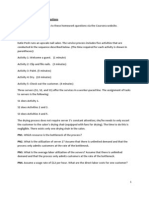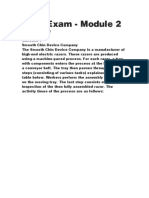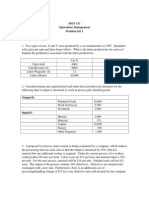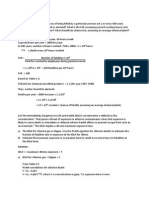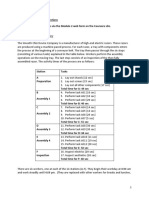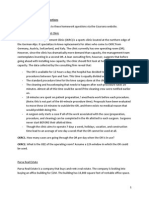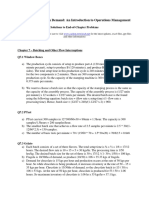Module 3 Practice Solutions UPLOADED
Uploaded by
jigar_3008Module 3 Practice Solutions UPLOADED
Uploaded by
jigar_3008Module
3 Practice Solutions Two-Step Process TS1. Capacity of Step B is 15 / (9 + 0.1 x 15) = 1.43 units per minute. Step A makes 1 unit per minute, so the bottleneck is the first step and the capacity of the process is 1. TS2. Recommended batch size = 1 x 9 / (1 - 1 x 0.1) = 10 Milk shake production MSP1. Total demand = 17.5 gal/hr. Total setup time = 1 hr. Processing time p = 1/30 hr/gal. Setting capacity = demand and solving for B gives B=42 gal. MSP2. 42*10/17.5=24 Irish Call Center (ICC) ICC1. Answer: Option e.
You might also like
- Homework Assignment Module 2 - Process Analysis100% (3)Homework Assignment Module 2 - Process Analysis7 pages
- Coursera Operation Management Final Exam Questions - Module 212% (25)Coursera Operation Management Final Exam Questions - Module 24 pages
- Homework Assignment: Module 2 - Process Analysis: Posh Nails100% (6)Homework Assignment: Module 2 - Process Analysis: Posh Nails49 pages
- OPIM101 - Practice Exam 1 - Solutions PDFNo ratings yetOPIM101 - Practice Exam 1 - Solutions PDF14 pages
- OPIM101 - Spring 2009 - Exam 1 - SolutionsNo ratings yetOPIM101 - Spring 2009 - Exam 1 - Solutions12 pages
- Matching Supply With Demand Solutions To End of Chapter Problems 4100% (1)Matching Supply With Demand Solutions To End of Chapter Problems 46 pages
- Opre6302 Operations Management Assignment #30% (3)Opre6302 Operations Management Assignment #33 pages
- CN3135 Revision Tutorial Qns and SolutionsNo ratings yetCN3135 Revision Tutorial Qns and Solutions5 pages
- Coursera Operation Management Final Exam Questions - Module 20% (2)Coursera Operation Management Final Exam Questions - Module 24 pages
- Final Exam - Module 2: Smooth Chin Device Company0% (1)Final Exam - Module 2: Smooth Chin Device Company16 pages
- Chapter 3 Work Flow and Batch Processing MN0% (1)Chapter 3 Work Flow and Batch Processing MN87 pages
- OPIM101 - Spring 2015 - Mentoring 3 - Questions and Answers PDF0% (2)OPIM101 - Spring 2015 - Mentoring 3 - Questions and Answers PDF34 pages
- Matching Supply With Demand: An Introduction To Operations ManagementNo ratings yetMatching Supply With Demand: An Introduction To Operations Management4 pages
- Module 2 - Capacity Planning Practice ProblemsNo ratings yetModule 2 - Capacity Planning Practice Problems3 pages
- Practice_Quiz_6_-_Process_Interruptions__Operations_ManagementNo ratings yetPractice_Quiz_6_-_Process_Interruptions__Operations_Management6 pages
- CS4617 Computer Architecture: Lecture 2aNo ratings yetCS4617 Computer Architecture: Lecture 2a13 pages
- Test Bank for Matching Supply with Demand: An Introduction to Operations Management, 4th Edition, Gerard Cachon, Christian Terwiesch - Instantly Accessible In Full PDF Version100% (3)Test Bank for Matching Supply with Demand: An Introduction to Operations Management, 4th Edition, Gerard Cachon, Christian Terwiesch - Instantly Accessible In Full PDF Version46 pages















